Green Mamba (original) (raw)
Green mambas are fast and can travel up to 7 miles per hour.
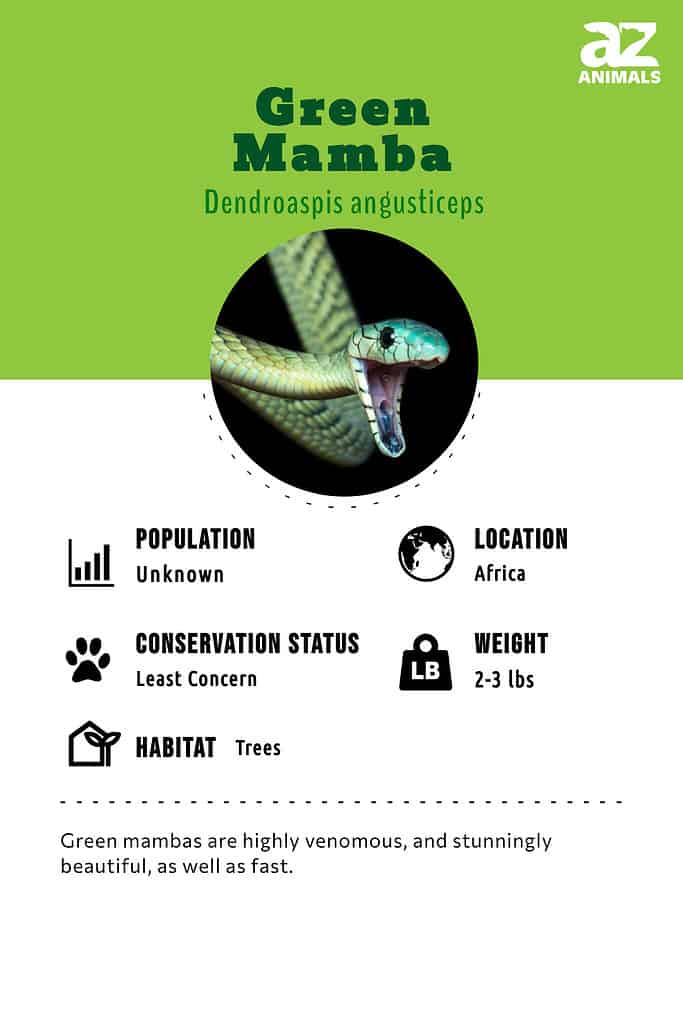
In the thick forests of Western and Eastern Africa, you might find a deadly creature slithering through the Cashew and Coconut trees. These highly venomous, and stunningly beautiful, snakes have two varieties – the Western and Eastern Green Mambas. These long, slender snakes have narrow heads that are disturbingly coffin-shaped.
They are almost completely arboreal, living most of their solitary lives in the trees. The only time they leave their tree-top home is to change trees, bask, or mate. Both species are shy and would rather find an escape route than take a bite out of a person. However, when they do decide to bite it can be fatal in as little as 30 minutes, so immediate medical care is vital to survival.
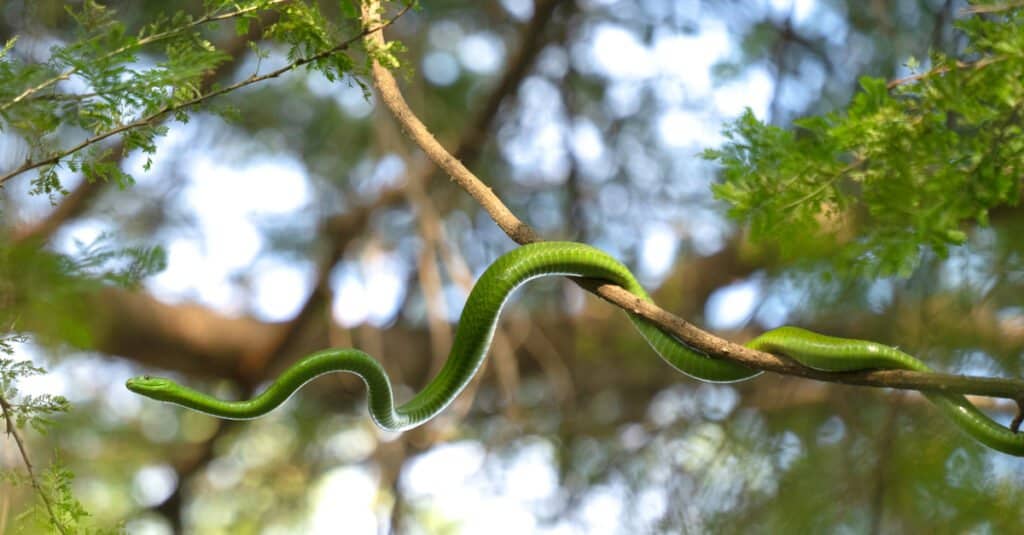
The green mamba is a long, slender-bodied snake with smooth scales and a narrow, coffin-shaped head.
©Dominyk Lever/Shutterstock.com
3 Amazing Facts About Green Mambas
- A bite from a Green Mamba can cause death in as little as 30 minutes with a severe bite, but it often takes several hours.
- They rarely come out of the trees except to change trees, bask, or mate.
- Unlike other venomous snakes that hold their prey after biting it, green mambas bite and immediately release it; then wait for it to succumb to their potent venom.
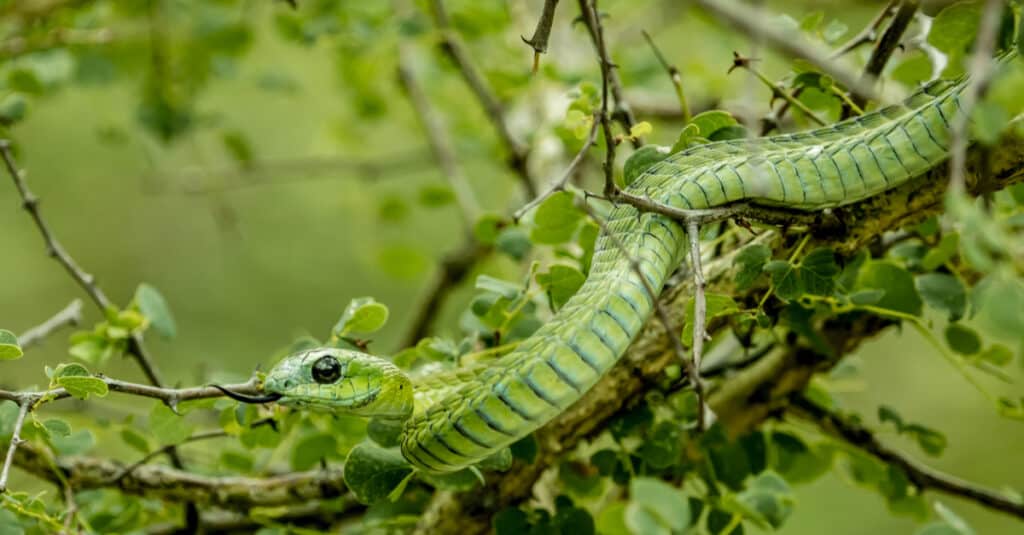
Western green mambas are bright green towards the head, shifting to yellow or orange at the tail.
©OrodO/Shutterstock.com
Where To Find
Green mambas prefer dense, well-shaded vegetation, and wild forests. You might find these beautiful but-deadly snakes slithering through coconut groves, cashew trees, and dense thickets. They are very adaptable, and where human development has overtaken the forest they make a home for themselves among the shrubbery if where it’s thick enough. There are many verified sightings and captures in neighborhoods and homes in their native ranges.
A green mamba can move almost 7 miles per hour and often try to escape before confronting a human. They’re rather shy snakes, so bites from them are relatively rare – if often fatal when untreated.
It is an opportunistic hunter and spends its days either stationary while waiting for prey to wander within its reach, or actively hunting small prey in the trees such as birds and their eggs, lizards, and bats.
Eastern Green Mambas
You’ll find eastern green mambas in the trees of coastal tropical forests in East Africa in Kenya, Tanzania, Malawi, Zimbabwe, Zambia, Mozambique, and South Africa.
Western Green Mambas
These snakes inhabit the coastal rainforests in the West African countries of Gambia, Senegal, Guinea-Bissau, Guinea, Sierra Leone, Liberia, Cote d’Ivoire (Ivory Coast), Ghana, Togo, and Benin.
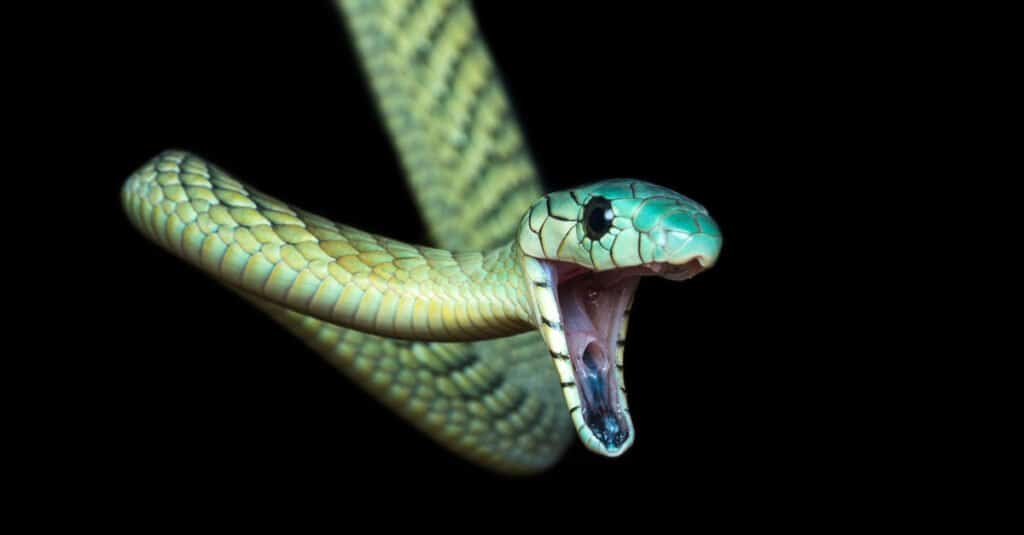
Western green mambas (D. viridis) inhabit coastal rainforests in West Africa.
©Sibons photography/Shutterstock.com
Scientific Name
These snakes are members of the Elapidae family, along with King Cobras and coral snakes. They are both species in the Dendroaspis genus of snakes. Dendroaspis comes from Greek, it’s a compound word formed from dendron which means tree; and aspis, a generic term once used to describe any venomous snake; now, it’s only applied to a few snakes.
The eastern green mamba’s scientific name, Dendroaspis angusticeps, means “Narrow-headed Tree Asp,” angusticeps is Latin and means narrow-headed. The Western Green Mamba’s scientific name, Dendroaspis viridis, is a little different and viridis means green, hence Dendroaspis viridis means “Green Tree Asp.”
Their common name, mamba, is a borrowed word from either Swahili or Zulu.
Green mambas are one of the most feared snakes in Africa.
The 4 Types of Mambas
There are four types of Mamba snakes that we know of so far:
- Eastern green mamba (Dendroaspis angusticeps) makes its homes in the coastal rain forests of East Africa.
- Western green mamba (Dendroaspis viridis) inhabits the coastal rainforests of West Africa.
- Black mamba (Dendroaspis polylepis) is both terrestrial and arboreal, inhabiting savanna, woodland, rocky slopes, and forests of central and southern Africa.
- Jameson’s mamba (Dendroaspis jamesoni) looks similar to Western Green Mambas and inhabits areas of western and central Africa.
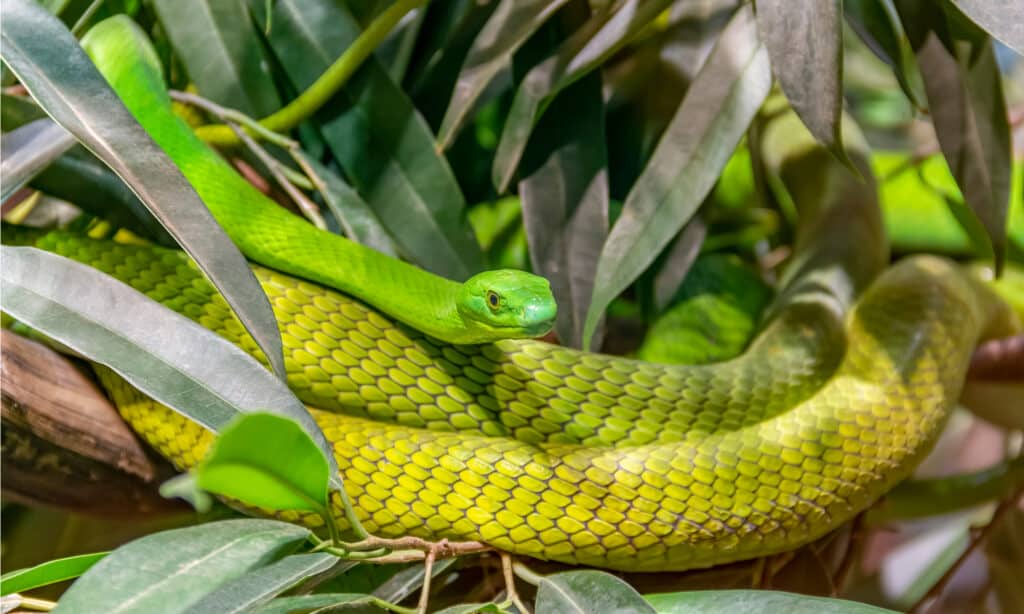
Green mambas are fairly common throughout their range, and biologists believe their population is stable.
©PRILL/Shutterstock.com
Population and Conservations Status
Both green mambas species are listed on the IUCN Redlist as Least Concern; they are fairly common throughout their range, and biologists believe their population is stable. These snakes are generalists and have flexible habits, so they can adapt to changes in their environment. They can make their homes anywhere there’s an adequate amount of cover, such as shrubbery around buildings; despite a fractured native range they appear to be thriving.
They have few natural predators, but black-headed herons and birds of prey include them in their diet. Their main threat is human encroachment, but they seem to be meeting that challenge with few problems.
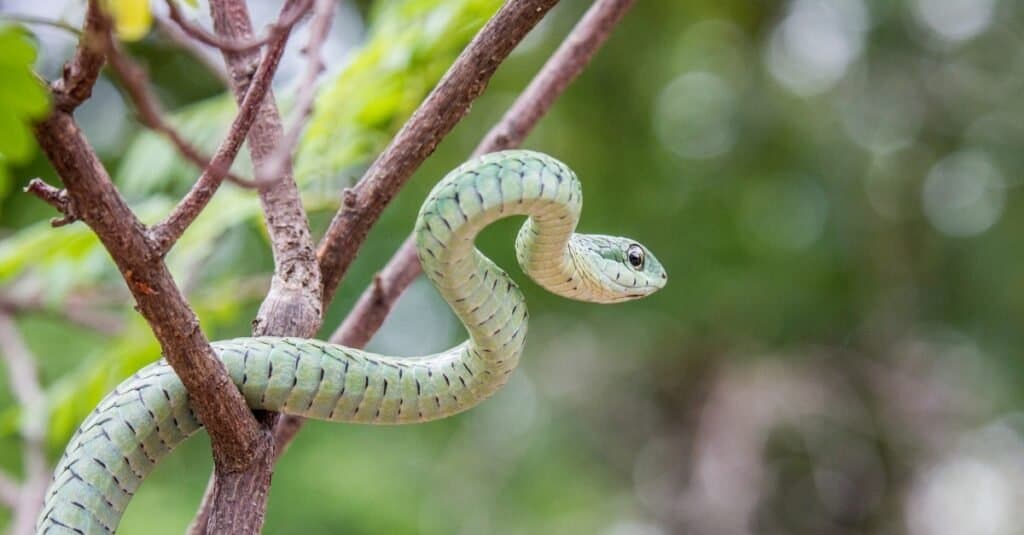
The green mamba is one of the most beautiful green animals, and also some of the most venomous snakes on earth.
©iStock.com/Simoneemanphotography
Appearance and Description
Both of these species range in length from 4-7 feet as adults while hatchlings average between 14-24 inches. They have medium eyes with round pupils. Green Mambas mate during the rainy season between April and June, then in October or November lay a clutch of 4-17 eggs in leaf litter in hollow trees. Hatchlings emerge about 90 days later.
Western Green Mambas are varying shades of bright green on their backs with yellow-green bellies, fading to orange or yellow at the tail. There are dark margins between their large scales that give them a striking appearance. Juveniles are often turquoise and develop their bright green as they mature into adults.
Eastern Green Mambas are also bright green but lack the dark margins between scales; they have a velvety appearance and occasional yellow scales as adults, as juveniles they’re often blue-green or turquoise.
Green Mambas are often confused with harmless green snakes from the Philothamnus genus and the venomous green Boomslang. Both types of snakes are shades of green, making identification a little difficult if all you saw was a flash of green moving through the brush. However, only the boomslang is venomous.
Venom extraction is an important part of producing antivenom for snakebite victims’ treatment.
Venom: How Dangerous Are Green Mambas?
These snakes are beautiful but highly venomous, and should not be handled except by experienced herpetologists. They rarely bite but possess a type of quick-acting venom. So, if you are bitten by the venomous green mamba, then you would likely begin seeing its effects as soon as 15 minutes following being bitten. Bites with severe envenomation can cause death in as little as 30 minutes to a few hours. The good news is that antivenom is effective, and can often reverse symptoms quickly.
Symptoms of a Green Mamba Bite
This snake’s venom can be deadly very quickly. Symptoms include:
- At the snakebite site, general pain and swelling.
- General symptoms include shock, hypotension, abdominal pain, nausea, vomiting, fever, flushing of the face, increased sweating, breathing distress, and heart problems.
Treatment with green mamba bites is very effective but often requires up to 10 vials of antivenom. Fortunately, they only rarely bite humans and would rather escape than bite.
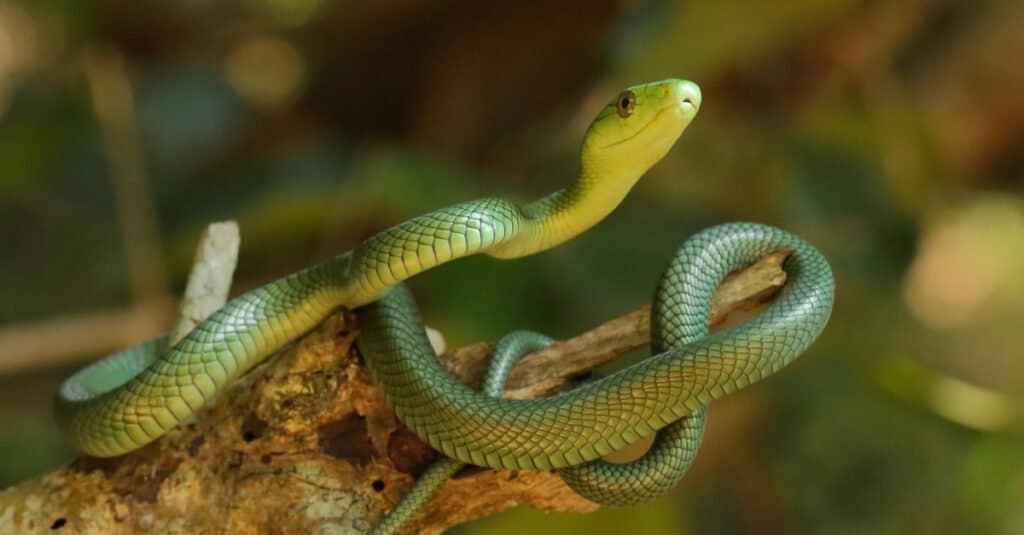
Juvenile green mamba striking a pose. Juveniles are blue-green, becoming bright green when they are around 75 centimeters (2 ft 6 in) long.
©NickEvansKZN/Shutterstock.com
Behaviour & Humans
As we humans steadily advance and our cities and towns grow, many animals have found it difficult to compete. Green mambas do not appear to be in that situation. These snakes are highly adaptable. Even though human encroachment has caused a loss and fracturing of their preferred habitat, they are quite happy making new homes in dense shrubbery surrounding buildings and homes.
In as much as they have happily moved right into human-created environments, they’re still more likely to flee than fight. Some have said that they were bad-tempered, but others believe that they’re nervous. In any case, they don’t tend towards aggression, and bites are rare unless the snake is startled or harassed.
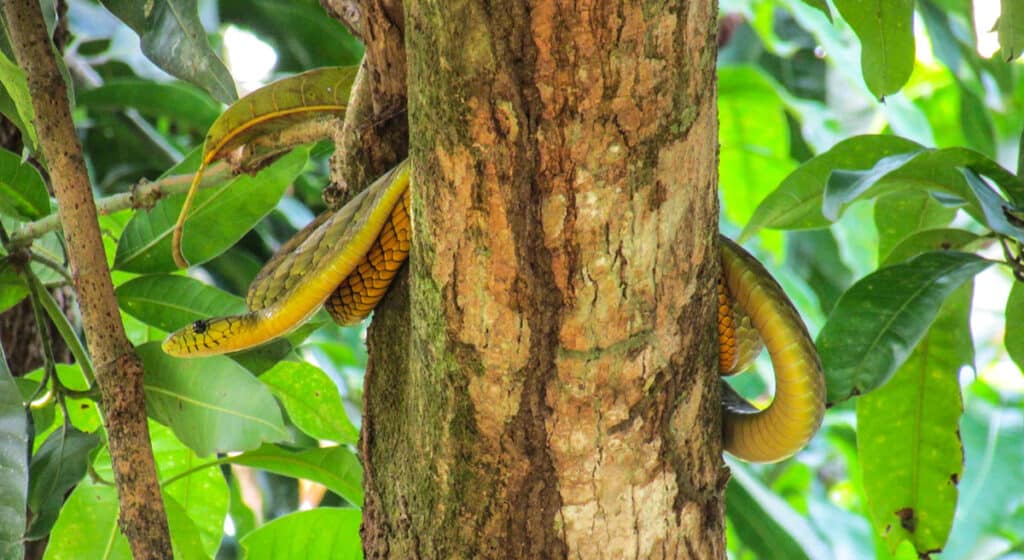
Western green mambas (D. viridis) often rest in trees, waiting for prey to wander too close.
©© yakoo1986, some rights reserved (CC-BY-NC) – Original / License
Evolution and Origin
Though quite an elusive snake, green mambas have been feared by Africans for generations because of their highly venomous bite. It was first discovered in 1849 by zoologist Andrew Smith, who found it in Natal and Maputo Bay. He named it Naja angusticeps. More scientists still tried to name it further, such as in 1865, zoologist Albert Günther called it as Dendroaspis intermedius while in northern Mozambique.
In 1896, things got even more complicated when zoologist George Albert Boulenger put together the green mamba species with that of the black mamba. This remained in place until 1946 when a paper was published by herpetologist Vivian FitzSimons, who noted the differences in coloration, scalation, build, and behavior of the two snake species. This led to their separation, where green mamba was finally on its own again. There still is a close relation, as a 2016 genetic analysis shows the eastern green mamba and the black mamba are close relatives.
Similar Animals
View all 220 animals that start with G
Yes! Their venom contains both neurotoxins and cardiotoxins, with symptoms that can include dizziness, swelling at the bite, difficulty breathing and swallowing, irregular heartbeat, and convulsions.
Biologists believe them to be relatively sedentary, mostly waiting for their prey. However, they are known to actively seek prey such as birds and their eggs.
No, they’re quite shy and prefer to avoid a confrontation whenever possible. They’ll attack if they’re threatened, but otherwise are pretty docile.
The two varieties of Green Mambas live in coastal tropical forests but can range up to 4,000 feet above sea level. The East African countries of Kenya, Tanzania, Malawi, Zimbabwe, Zambia, Mozambique, and South Africa host the Eastern Green Mamba; while West African countries of Gambia, Senegal, Guinea-Bissau, Guinea, Sierra Leone, Liberia, Cote d’Ivoire (Ivory Coast), Ghana, Togo, and Benin are hosts to the Western Green Mamba.
Their favorite thing seems to be birds and their eggs; however, they’ve also been known to eat bats, lizards, and small mammals.
There are many differences between black mambas and green mambas, including their size and coloring. Black mambas have a hood that is similar to cobras, while green mambas do not. They are also very different colors!
The key differences between Green Mambas and King Cobras are their size, weight, morphology, distribution, diet, and venom. Typically, a Green Mamba is smaller and less heavy than a King Cobra. Besides, while King Cobras have hoods on their heads, Green Mambas, apart from the eastern Green Mamba, don’t have hoods when their heads are raised.
The key differences between green mambas and boomslangs lie in their size, appearance, color, and venom. Green mambas are generally heavier, longer, and deadlier than boomslangs.
The major difference between a green mamba and a green tree snake lies in their size.